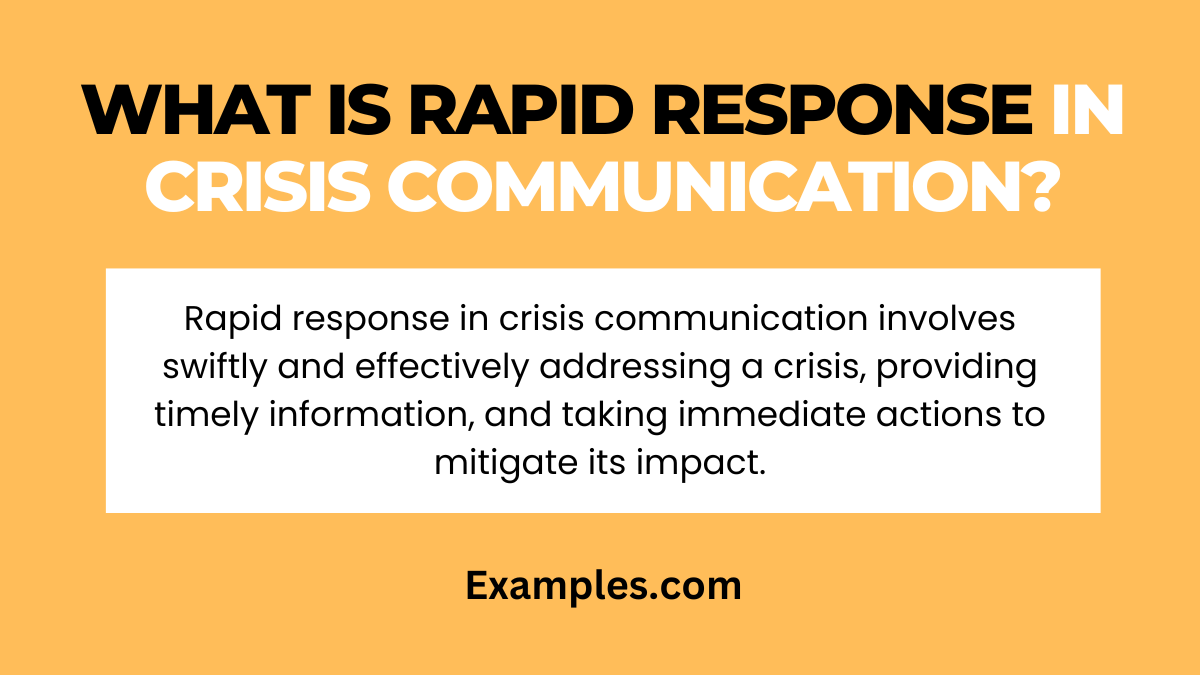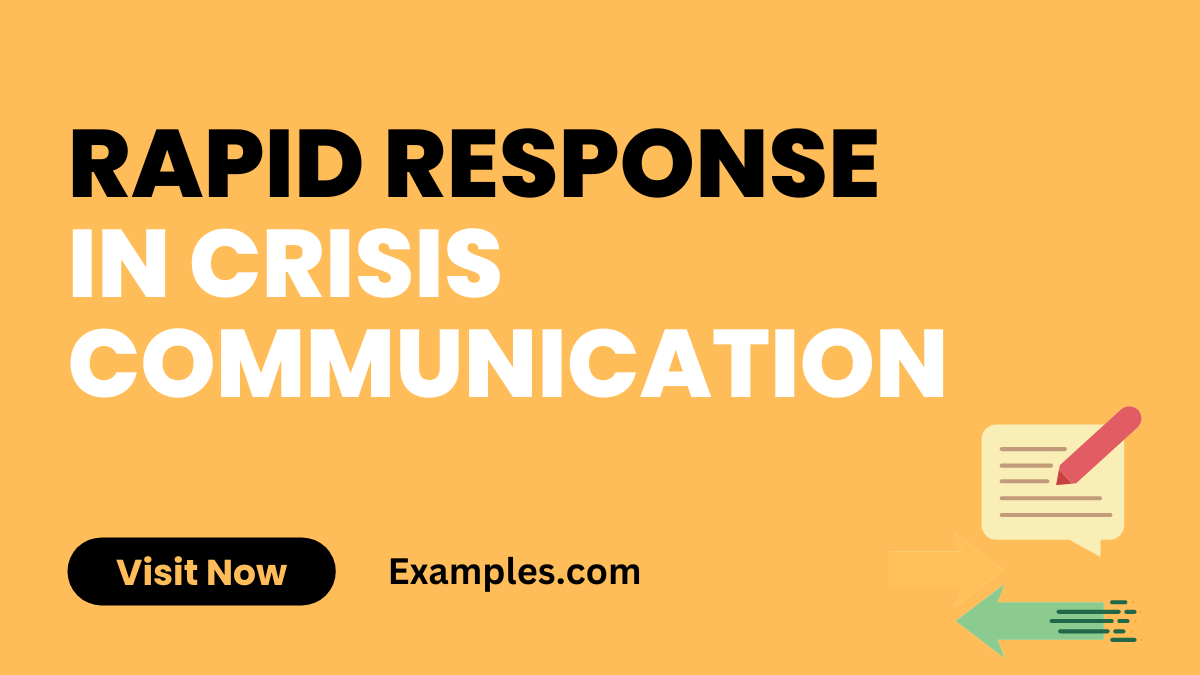Rapid Response in Crisis Communication
In the realm of crisis management, Rapid Response in Crisis Communication stands paramount. This guide offers a deep dive into mastering rapid response techniques, ensuring your message is clear, impactful, and timely. From Transparent Communication to Preparedness Planning, we cover a spectrum of strategies backed by real-world examples. Learn how to effectively navigate the complexities of crisis communication, ensuring your response is swift, appropriate, and effective.
What is Rapid Response in Crisis Communication?

Rapid Response in Crisis Communication refers to the immediate and effective communication actions taken during a crisis to manage information dissemination and public perception. It involves swift decision-making, clear messaging, and strategic media management to address the situation, alleviate concerns, and maintain trust among stakeholders. Rapid response is crucial in mitigating the impact of a crisis, ensuring accurate information reaches the right audience at the right time.
20 Examples of Rapid Response in Crisis Communication
Rapid Response in Crisis Communication is crucial for mitigating the impact of a crisis. It involves immediate action and communication to address the situation effectively. Rapid response helps in maintaining trust and credibility, while minimizing damage to the organization’s reputation. It requires a well-prepared crisis communication plan, skilled crisis communication team, and the ability to communicate swiftly and accurately across various channels.
- Social Media Updates During a Natural Disaster: Posting regular updates on social media platforms to inform and guide affected individuals.
Example: “We are coordinating with emergency services and will provide shelter locations shortly.” - Immediate Press Release after a Data Breach: Issuing a press release acknowledging the breach and informing stakeholders about the steps being taken.
Example: “We are investigating the breach and will ensure enhanced security measures going forward.” - CEO’s Public Statement in a Product Recall: The CEO addressing the public with transparency regarding a product recall.
Example: “We apologize for any inconvenience caused and are working to rectify the issue.” - Live Updates During a Crisis Event: Providing live updates through a dedicated crisis hotline or website.
Example: “Our response teams are on the ground, and we will keep you informed about the progress.” - Email Communication to Employees During an Internal Crisis: Sending timely and clear emails to employees about an ongoing internal issue.
Example: “Your safety is our priority. Please follow the instructions provided by your managers.” - Customer Service Response to Consumer Complaints: Addressing consumer complaints swiftly on customer service platforms. Example: “We understand your concern and are looking into the matter immediately.”
- Use of Chatbots for Instant Response: Deploying chatbots to provide instant information and guidance during a crisis.
Example: “Please enter your query, and I will assist you with the latest information.” - Emergency Text Alerts to Local Communities: Sending out emergency text alerts to inform and instruct local communities.
Example: “Please evacuate the area immediately as instructed by the authorities.” - Interactive Social Media Q&A Sessions: Hosting Q&A sessions on social media to address concerns and questions.
Example: “We are here to answer your questions. Please post them below.” - Real-time Monitoring and Response on Social Media: Monitoring social media for misinformation and responding with factual information.
Example: “This information is incorrect. Please refer to our official channels for updates.” - Webinar for Crisis Communication Training: Organizing a webinar to train employees on crisis communication.
Example: “Join our webinar to understand how you can contribute during a crisis.” - Updating Website FAQs During a Crisis: Regularly updating the FAQ section on the organization’s website to reflect current information. Example: “We have updated our FAQs to address your recent concerns.”
- Video Message from the Management: Releasing a video message from the management to address and reassure stakeholders.
Example: “We are committed to resolving this situation as quickly as possible.” - Collaboration with Influencers for Message Spread: Collaborating with influencers to spread the crisis communication message. Example: “We have partnered with [Influencer] to reach a wider audience.”
- Virtual Press Conferences: Holding virtual press conferences to address media queries in real-time.
Example: “We will be taking your questions now. Please raise your hand in the app.” - Community Forums for Stakeholder Engagement: Creating community forums for stakeholders to voice their concerns and receive updates.
Example: “Join our forum to stay updated and share your thoughts.” - Partnership Announcements for Crisis Mitigation: Announcing partnerships with other organizations for crisis response.
Example: “We are working together with [Organization] to address this crisis.” - Employee Briefings via Video Conferencing: Conducting employee briefings through video conferencing for immediate updates. Example: “Please join the briefing to receive important instructions.”
- Utilizing Podcasts for Crisis Communication: Releasing special podcast episodes to discuss the crisis and communicate responses. Example: “Listen to our latest podcast episode for a detailed update on the situation.”
- Interactive Crisis Communication Apps: Launching an app specifically designed for crisis communication and updates.
Example: “Download our crisis communication app for real-time updates and assistance.”
Stages of Rapid Response in Crisis Communication

1. Assessment and Monitoring: The initial stage involves assessing the crisis situation and monitoring ongoing developments. This stage is crucial for understanding the severity and potential impact of the crisis.
2. Planning and Strategy Development: Developing a strategic response plan tailored to the specific crisis is vital. This plan should include clear objectives and actions.
3. Team Mobilization: Assembling a dedicated crisis communication team is crucial. This team should include members with expertise in various areas, such as media relations, social media, and stakeholder engagement.
4. Message Development: Crafting clear, concise, and consistent messages is essential. Messages should be tailored to different audiences and channels.
5. Information Dissemination: Utilizing various channels, such as press releases, social media, and direct communication, to disseminate the information to the public and stakeholders.
6. Media Management: Engaging with the media effectively to manage the narrative and ensuring accurate information dissemination is vital.
7. Monitoring and Adjusting: Continuously monitoring the situation and public response, and adjusting strategies and messages as needed.
8. Post-Crisis Analysis and Learning: After the crisis, evaluating the response effectiveness and learning from the experience to improve future crisis communication strategies is critical.
When Should You Use Rapid Response in Crisis Communications Programs?
1. Immediate Threat or Danger: When a crisis poses an immediate threat to public safety or the organization.
2. High Public Interest: In situations that garner significant public or media attention, a rapid response is necessary to manage perceptions and information flow.
3. Potential for Escalation: If there’s a risk of the crisis escalating without prompt intervention.
4. Legal or Regulatory Implications: When a crisis has potential legal or regulatory consequences, rapid response is crucial for compliance and mitigation.
5. Stakeholder Impact: If key stakeholders, such as customers, employees, or investors, are directly impacted, a swift response is necessary to maintain trust and relationships.
6. Reputation Risk: In scenarios where the organization’s reputation is at stake, a rapid response can help mitigate negative impacts.
7. Social Media Activity: High levels of activity or misinformation spreading on social media platforms require immediate attention.
8. Learning from Past Crises: If previous crises have shown the need for quicker responses, applying those lessons in future crises is essential.
In crafting an effective conclusion for a guide on Rapid Response in Crisis Communication, it’s essential to underscore the Importance of Crisis Communication. Rapid response is a critical component of successful crisis management, ensuring timely and accurate dissemination of information to stakeholders. This approach not only mitigates the immediate impact of a crisis but also aids in preserving the organization’s reputation. Employing clear, transparent communication strategies and maintaining consistency in messaging are key. Remember, a well-handled crisis can transform a challenging situation into an opportunity for trust-building and reaffirmation of organizational values.



